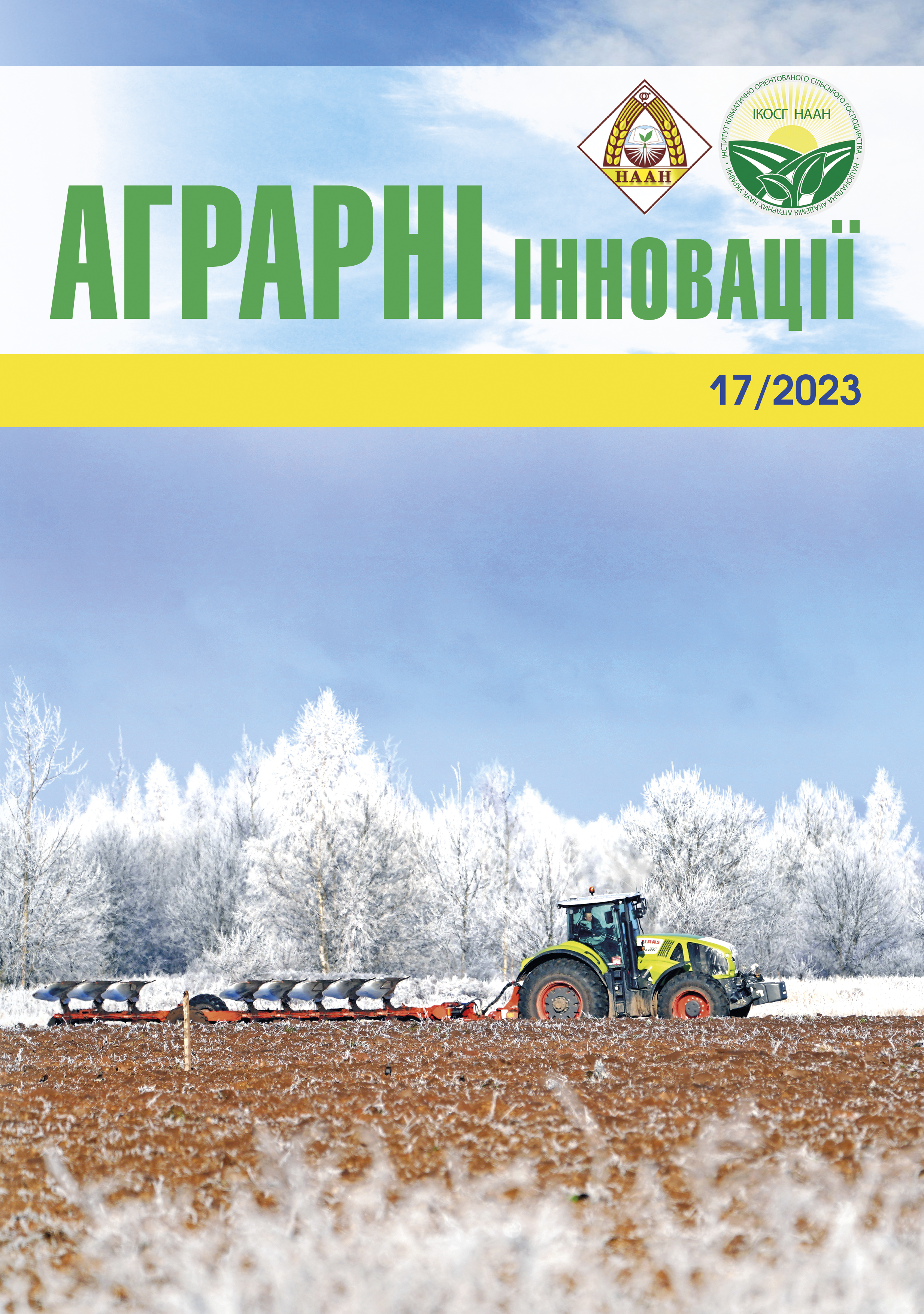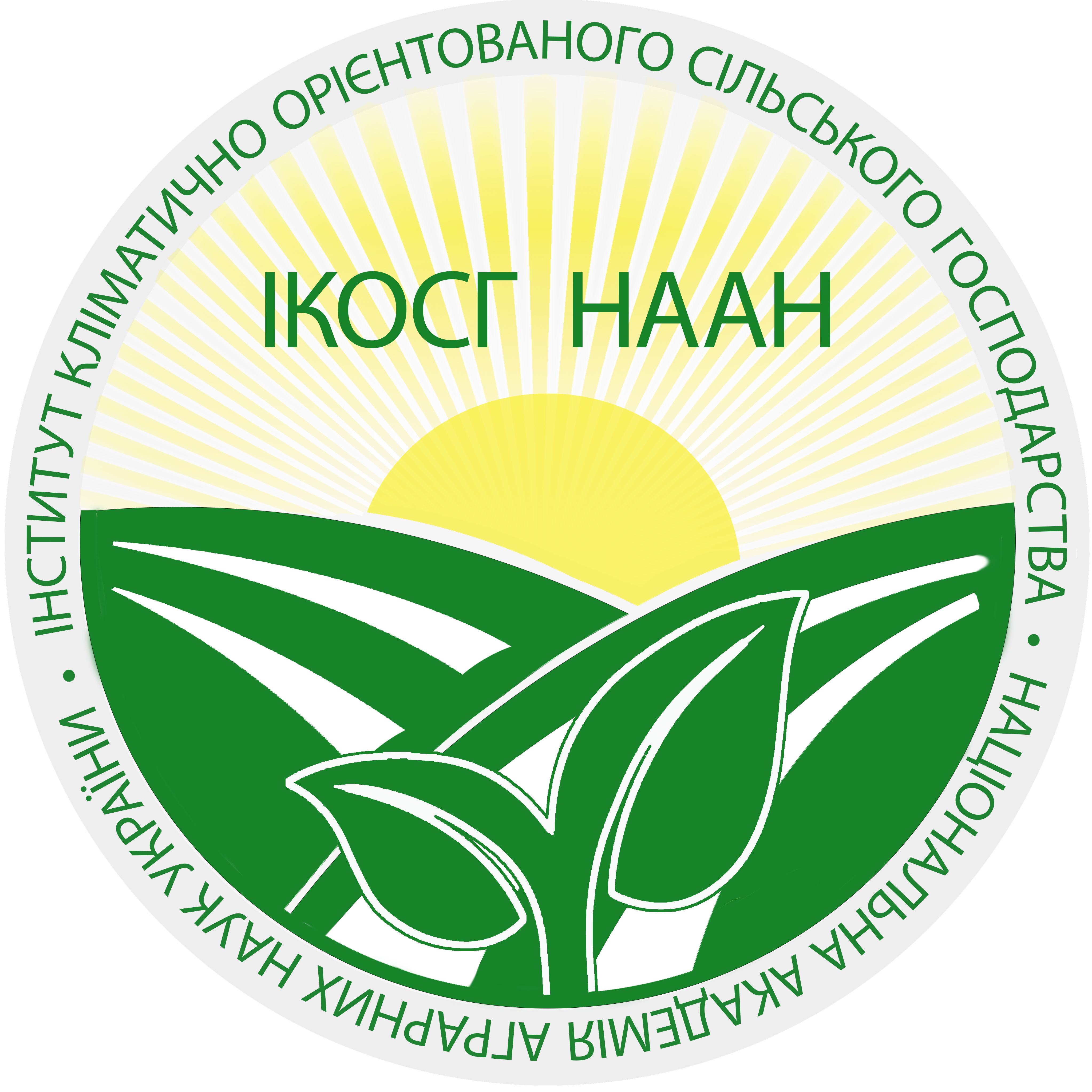ОЦІНКА СОРТІВ КАРТОПЛІ ЗА СТІЙКІСТЮ ДО ПОСУХИ В УМОВАХ ЦЕНТРАЛЬНОГО ПОЛІССЯ УКРАЇНИ
Анотація
Мета досліджень. Оцінити сорти картоплі різних груп стиглості вітчизняної селекції у різних середовищах та виділити генотипи з високою продуктивністю і стійкістю до посухи з подальшим використанням їх в селекційній практиці. Матеріали і методи. Дослідження проведені впродовж 2018–2019 і 2021–2022 рр. в польових умовах селекційної сівозміни лабораторії селекції Поліського дослідного відділенні Інституту картоплярства НААН України. Об’єктом досліджень слугували 26 сортів картоплі різних груп стиглості. Методи досліджень польові, селекційні і математично-статистичні. Результати досліджень. Для диференціації сортів картоплі за реакцією на стійкість до посухи було використані індекс сприйнятливості до посухи, індекс толерантності до посухи, індекс стабільності урожаю, індекс урожайності, індекс толерантності до стресу, індекс посухостійкості, відносний індекс посухи, індекс продуктивності в стресових і сприятливих умовах. За результатами досліджень встановлено, що за період 2018–2019 рр. за комплексом вищого значення показників індексів до середнього групи стиглості проявили сорти: в групі ранніх – Серпанок, Вигода, Бажана, Світана і Радомисль; серед середньоранніх – Партнер, Межирічка 11, Фанатка, Сонцедар і Опілля; поміж середньостиглих – Базалія, Чарунка і Володарка; в середньопізній групі – Червона рута, Олександрит і Роставиця. Досліджено, що в період 2021–2022 рр. найвище значення індексів посухостійкості продемонстрували сорти: серед ранньостиглих – Серпанок, Тирас, Світана, Взірець і Радомисль; в середньоранніх – Партнер, Межирічка 11, Сонцедар і Левада; поміж середньостиглих – Базалія, Чарунка, Явір, Альянс і Іванківська рання; в середньопізніх – Червона рута і Олександрит. Висновки. Використання в селекційній практиці індексного підходу з оцінки посухостійкості значного обсягу генотипів картоплі дозволяє виділити високоврожайний матеріал в умовах стресу і його відсутності. В подальшому виділені стійкі до посухи сорти картоплі можна рекомендувати для вирощування в менш сприятливих ґрунтово-кліматичних зонах України та використання їх в селекційних програмах зі створення стресостійких генотипів.
Посилання
2. Bach S., Yada R. Y., Bizimungu B., Sullivan J. A. Genotype by environment interaction effects on fibre components in potato (Solanum tuberosum L.). Euphytica. 2012. Vol.187. P. 77–86. doi.org/10.1007/s10681-012-0734-9
3. Верменко Ю. Я., Демкович Я. Б., Остренко М. В. Споживча, лікувальна цінність та придатність до переробки різних сортів картоплі. Агробіологія. 2016. № 1 (124). С. 66–72.
4. Devaux A., Goffart J. P., Petsakos A. et al. Global food security, contributions from sustainable potato agrifood systems. The Potato Crop: Its Agricultural, Nutritional and Social Contribution to Humankind. H. Campos, O. Ortiz (Eds.). Cham (Switzerland). Springer, Cham., 2020. P. 3–35. doi.org/10.1007/ 978-3-030-28683-5_1.
5. Monneveux P., Ramírez D. A., Pino M.-T. Drought Tolerance in Potato (S. Tuberosum L.): Can We Learn Drought Tolerance Research in Cereals. Plant Sci. 2013. Vol. 205. 76–86. doi.org/10.1016/j.plantsci. 2013.01.011
6. Hijmans R.J. The effect of climate change on global potato production. Am. J. Pot Res. 2003.Vol. 80. P. 271–279. doi.org/10.1007/BF02855363
7. Wang Y., Frei M. Stressed food – the impact of abiotic environmental stresses on crop quality. Agr. Ecosyst. Environ. 2011. Vol. 141. P. 271–286. doi: 10.1016/j. agee.2011.03.017
8. Gregory P. T., Marshall B. Attribution of climate change: a methodology to estimate the potential contribution to increases in potato yield in Scotland since 1960. Glob. Chang. Biol. 2012. Vol. 18. P. 1372–1388. doi: 10.1111/j.1365-2486.2011.02601.x
9. Hatfield J. L., Boote K. J., Kimball B. A., Ziska L. H., Izaurralde D. R., Ort D., Thomson A. M., Wolfe D. Climate impacts on agriculture: Implications for crop production. J. Agron. 2011. Vol. 103. P. 351–370. doi.org/10.2134/ agronj2010.0303
10. Vandegeer R., Miller R. E., Bain M., Gleadow R. M., Cavagnaro T. R. Drought adversely affects tuber development and nutritional quality of the staple crop cassava (Manihot esculenta Crantz). Funct. Plant Biol. 2012. Vol. 40. P. 195–200. doi.org/10.1071/FP12179
11. Hussain S. S., Raza H., Afzal I., Kayani M. A. Transgenic plants for abiotic stress tolerance: Current status. Archives of Agronomy and Soil Science. 2012. Vol. 58 (7). Р. 693–721. doi: 10.1080/03650340.2010. 540010.
12. Mollasadeghi V., Valizadeh M., Shahryari R., Imani A. A. Evaluation of end drought tolerance of 12 wheat genotypes by stress indices. World Applied Sciences Journal. 2011. Vol. 13(3) P. 545–551.
13. King B.A., Stark J. C., Neibling H. Potato Irrigation Management. Potato Production Systems. J. Stark, M. Thornton, P. Nolte (Eds.). Cham : Springer International Publishing. 2020. P. 417–446. https://doi.org/10.1007/ 978-3-030-39157-7_13
14. Obidiegwu J., Bryan G., Jones G., Prashar A. Coping with drought: Stress and adaptive responses in potato and perspectives for improvement. Front. Plant Sci. 2015. Vol. 6. P. 542. doi.org/10.3389/fpls.2015.00542
15. Tang R., Niu S., Zhang G., Chen G., Haroon M., Yang Q., Rajora O. P., Li X. Q. Physiological and growth responses of potato cultivars to heat stress. Botany 2018. Vol. 96. P. 897–912. doi.org/10.1139/cjb-2018-0125
16. Ahn Y.-J., Claussen K., Zimmerman J. L. Genotypic differences in the heat-shock response and thermotolerance in four potato cultivars. Plant Sci. 2004. Vol. 166. P. 901–911. doi.org/10.1016/j.plantsci.2003.11.027
17. Zarzyńska K., Boguszewska-Mańkowska D., Nosalewicz A. Differences in size and architecture of the potato cultivars root system and their tolerance to drought stress. Plant Soil Environ. 2017. Vol. 63(4) P. 159–164. doi.org/10.17221/4/2017-PSE.
18. Weisz R., Kaminski J., Smilowitz Z. Water deficit effects on potato leaf growth and transpiration: Utilizing fraction extractable soil water for comparison with other crops. Am. Potato J. 1994. Vol. 71. P. 829–840. doi.org/10.1007/BF02849378
19. Ramirez D. A., Yactayo W., Rens L. R., Rolando J., Palacios S., De Mendiburu F., Mares V., Barreda C., Loayza H., Monneveux P. et al. Defining biological thresholds associated to plant water status for monitoring water restriction effects: Stomatal conductance and photosynthesis recovery as key indicators in potato. Agric. Water Manag. 2016. Vol. 177. P. 369–378. doi.org/10.1016/j.agwat.2016.08.028
20. Saravia D., Farfán-Vignolo E. R., Gutierrez R., De Mendiburu F., Schafleitner R., Bonierbale M., Khan M. A. Yield and Physiological Response of Potatoes Indicate Different Strategies to Cope with Drought Stress and Nitrogen Fertilization. Am. J. Potato Res. 2016. Vol. 93. P. 288–295. doi.org/10.1007/s12230-016-9505-9
21. Завірюха П. Д., Коновалюк М. Г., Косилович Г. О. та ін. Теоретичні і практичні аспекти селекції картоплі у Західному регіоні України. Генетичні ресурси рослин і селекція. 2012. С. 139–143.
22. Boguszewska-Mańkowska D., Ruszczak B., Zarzyńska K. Classification of Potato Varieties Drought Stress Tolerance Using Supervised Learning. Applied Sciences. 2022, Vol. 12(4). P. 1939–1955. https://doi. org/10.3390/app12041939
23. Hoelle J., Asch F., Khan A., Bonierbale M. Phenology- Adjusted Stress Severity Index to Assess Genotypic Responses to Terminal Drought in Field Grown Potato. Agronomy. 2020. 10(9). P. 1298–1314. https://doi. org/10.3390/agronomy10091298
24. Kebede Beyene Z., Mekbib F., Abebe T., Asfaw A. Drought Resistance Indices for Screening of Potato (Solanum tuberosum L.) Genotypes. Turkish Journal of Agriculture – Food Science and Technology. 2019. 7(8). P. 1118–1124. doi.org/10.24925/turjaf.v7i8.1118-1124. 2226
25. Saravia D., Farfán-Vignolo E. R., Gutierrez R., De Mendiburu F., Schafleitner R., Bonierbale M., Khan M. A. Yield and Physiological Response of Potatoes Indicate Different Strategies to Cope with Drought Stress and Nitrogen Fertilization. Am. J. Potato Res. 2016. 93. P. 288–295. doi.org/10.1007/s12230-016-9505-9
26. Stark J. C., Love S. L., King B. A., Marshall J. M., Bohl W. H., Salaiz, T. Potato Cultivar Response to Seasonal Drought Patterns. Am. J. Potato Res. 2013/ Vol. 90. P. 207–216. doi.org/10.1007/s12230-012-9285-9
27. Haverkort A. J., Van De Waart M., Bodlaender K .B. A. The effect of early drought stress on numbers of tubers and stolons of potato in controlled and field conditions. Potato Res. 1990. Vol. 33. P. 89–96. doi.org/10.1007/ BF02358133
28. Hill D., Nelson D., Hammond J., and Bell L. Morphophysiology of potato (Solanum tuberosum) in response to drought stress: paving the way forward. Front. Plant Sci. 2021. Vol. 11. P. 1–18. doi: 10.3389/ fpls.2020.597554
29. Martínez I., Muñoz M, Acuña I. and Uribe M. Evaluating the Drought Tolerance of Seven Potato Varieties on Volcanic Ash Soils in a Medium-Term Trial. Front. Plant Sci. 2021. Vol. 12. P. 1–14. doi: 10.3389/fpls. 2021.693060
30. Cabello R., Monneveux P., De Mendiburu F. et al. Comparison of yield based drought tolerance indices in improved varieties, genetic stocks and landraces of potato (Solanum tuberosum L.). Euphytica 2013. Vol. 193. P. 147–156. https://doi.org/10.1007/ s10681-013-0887-1
31. Chеrnobaі L. N., Ponurenko S. G., Sikalova O. V. Evaluation of stability for maize genotype characteristics by drought tolerance indices under different hydrothermal conditions. Wschodnioeuropejskie Czasopismo Naukowe (East European Scientific Journal). 2016. Vol. 8 (6). P. 69–75.
32. El-Hendawy S. E., Hassan W. M., Al-Suhaibani N. A. and Schmidhalter U. Spectral assessment of drought tolerance indices and grain yield in advanced spring wheat lines grown under full and limited water irrigation. Agric. Water Manag. 2017. Vol. 182. P. 1–12. doi: 10.1016/j.agwat.2016.12.003.
33. Nikneshan P., Tadayyon A., Javanmard M. Evaluating drought tolerance of castor ecotypes in the center of Iran. Heliyon. 2019. Vol. 5(4). P. 1403-1415. doi: 10.1016/j.heliyon.2019.e01403.
34. Fischer R. A., Wood T. Drought resistance in spring wheat cultivars ІІІ. Yield association with morphological traits. Australian Journal of Agricultural Research. 1979. Vol. 30 (6). Р. 1001–1020.
35. Bouslama M., Schapaugh W. T. Stress tolerance in soybean. Part 1: evaluation of three screening techniques for heat and drought tolerance. Crop Science. 1984. Vol. 24(5). C. 933–937.
36. Lin C. S., Binns M. R. and Lefkovitch L. P. Stability analysis: where do we stand? Crop Sci. 1986. Vol. 26. P. 894–900. doi: 10.2135/ cropsci1986.0011183X002600050012x
37. Fernandez G. C. J. Effective selection criteria for assessing plant stress tolerance. In Proceedings of the International Symposium on Adaptation Food Crops to Temperature and Water Stress / C. G. Kuo (Ed.). Shanhua, Taiwan, AVRDC, 13–18 August, 1992. P. 257–270. https://doi.org/10.22001/wvc.72511
38. Lan J. Comparison of evaluating methods for agronomic drought resistance in crops. Acta Agriculturae Borealioccidentalis Sinica. 1998. Vol. 7. P. 85–87.
39. Moosavi S. S., Yazdi Samadi B., Naghavi M. R, Zali A. A, Dashti H., Pourshahbazi A. Introduction of new indices to identify relative drought tolerance and resistance in wheat genotypes. Desert (Biaban). 2008. Vol. 12(2). Р. 165–178.
40. Fisher R. A., Maurer R. Drought resistance in spring wheat cultivars. 1. Grain yield responses. Australian Journal of Agricultural Research., 1978. 29(5). P. 897–912. doi.org/10.1071/AR9780897






